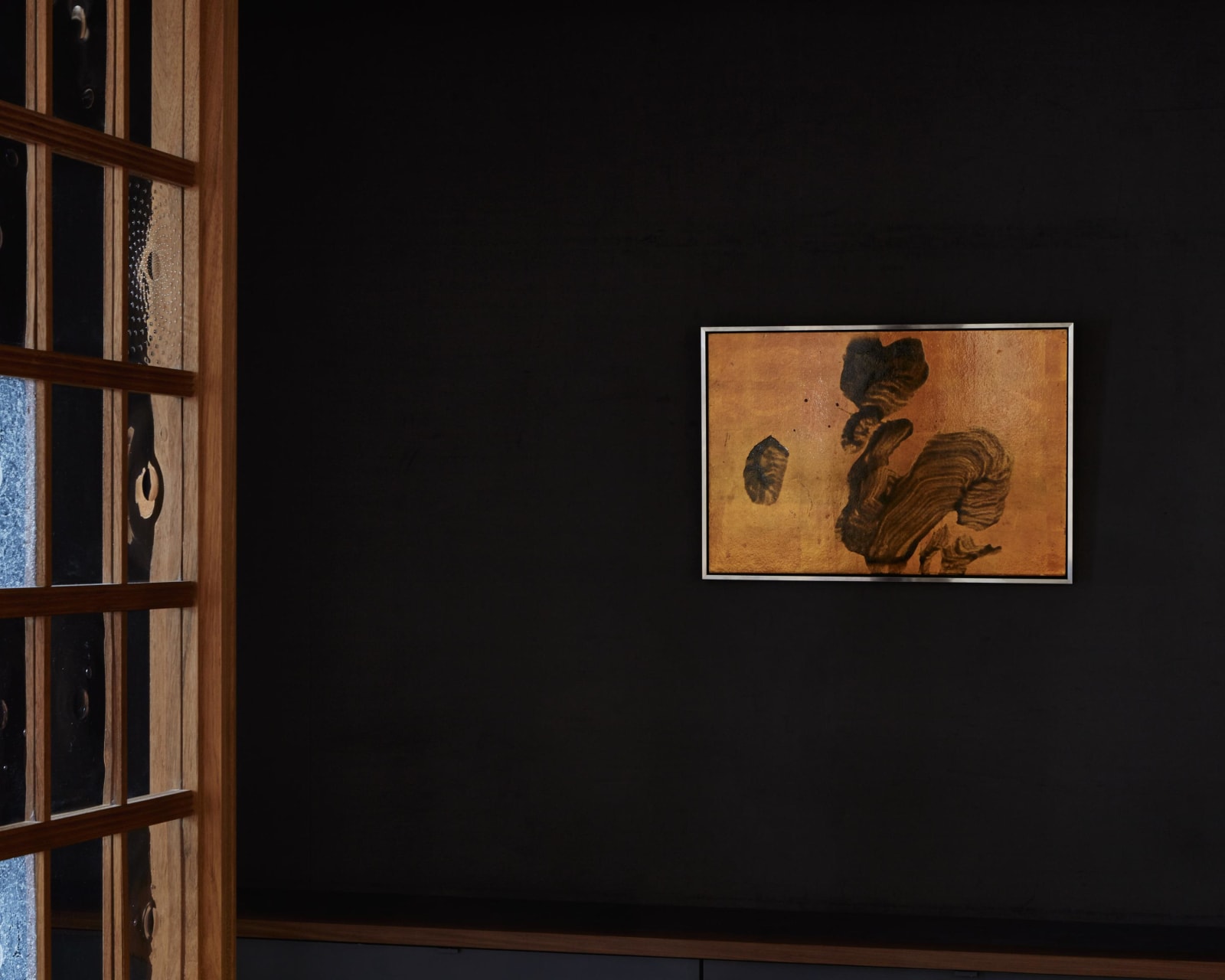Morita Shiryū (1912–1998)
Kan
Silver leaf, ink, and lacquer on paper, framed
1965
With a label signed by the artist
61 x 91 cm
64 x 94 cm (overall)
1965
With a label signed by the artist
61 x 91 cm
64 x 94 cm (overall)
Exhibitions
Morita, Iida, Sugai. Hannover: Brusberg Gallery, 1965.Literature
Morita Shiryu Catalogue Raisonné: 1952–1998. Uji: Soryusha, 2019.
Mixing an adhesive medium or nikawa glue with pigments on black Kent paper, finally sealing the surface with lacquer, was a technique that Morita started to use regularly from around 1964. On the one hand, from his experience abroad in the previous year he had learned that the delicacy of his papers and its susceptibility to stains had often proved a weak point of his works. Hence he devised a new technique, known as shikkin (lacquer and gold), as a means to cope with these drawbacks. At the same time, it would also become a new variation of calligraphy that he exploited for its expressive potential. Pigments mixed with glue easily preserved the movements of the brush. Morita tried gold and silver washes, but eventually favored aluminum flake pigment which provided a certain luster to the surface in synthetic glue as well as in nikawa. From the interaction of the lacquer with the pigment, the latter appearance as if of golden color. The artist had to exert particular care with his composition and he character’s meaning to not be overpowered by the sumptuous appearance. Yet over time, shikkin would become one of Morita’s signature techniques.
For Kan, made in 1965, Morita covered the paper first with silver leaf, then wrote the character with a mixture of glue and lamp soot, and finally sealed the surface with transparent lacquer. This particular combination of materials is rare for Morita. The best-known works are the present one, which was included in a group exhibition with Sugai Kumi and Iida Yoshikuni in Hannover; Kame, shown in the same year at the Bokujinkai Group Exhibition; and Chu from the Sankei Famous Masters Exhibition (now Kiyoshikojin Seichoji collection, near Kobe).
In the words of the artist, characters represent the place of one’s existence. On the label of the work, he wrote “Kwan” (an antiquated spelling of the character) and its associated meaning “having a clear perspective, self-realization through contemplation.” Compared to the shikkin works where he used aluminum flake pigment, the sheen is more mellow and brush movements are reflected more clearly, yet in its overall effect it is an equally strong work.
Morita Shiryu (avant-garde calligrapher; 1912–1998)
Avant-garde calligrapher from Hyogo Prefecture. Like fellow artist Inoue Yuichi, Morita studied under the calligraphy master Ueda Sokyu. He co-founded the avant-garde group Bokujinkai together with Inoue and was the founder and editor of the journal Bokubi (Beauty of Ink), both of which revolutionized traditional Japanese calligraphy and spread knowledge of Japanese avant-garde calligraphy to an international audience. He was posthumously awarded the Medal of Honor with Dark Blue Ribbon.
For Kan, made in 1965, Morita covered the paper first with silver leaf, then wrote the character with a mixture of glue and lamp soot, and finally sealed the surface with transparent lacquer. This particular combination of materials is rare for Morita. The best-known works are the present one, which was included in a group exhibition with Sugai Kumi and Iida Yoshikuni in Hannover; Kame, shown in the same year at the Bokujinkai Group Exhibition; and Chu from the Sankei Famous Masters Exhibition (now Kiyoshikojin Seichoji collection, near Kobe).
In the words of the artist, characters represent the place of one’s existence. On the label of the work, he wrote “Kwan” (an antiquated spelling of the character) and its associated meaning “having a clear perspective, self-realization through contemplation.” Compared to the shikkin works where he used aluminum flake pigment, the sheen is more mellow and brush movements are reflected more clearly, yet in its overall effect it is an equally strong work.
Morita Shiryu (avant-garde calligrapher; 1912–1998)
Avant-garde calligrapher from Hyogo Prefecture. Like fellow artist Inoue Yuichi, Morita studied under the calligraphy master Ueda Sokyu. He co-founded the avant-garde group Bokujinkai together with Inoue and was the founder and editor of the journal Bokubi (Beauty of Ink), both of which revolutionized traditional Japanese calligraphy and spread knowledge of Japanese avant-garde calligraphy to an international audience. He was posthumously awarded the Medal of Honor with Dark Blue Ribbon.



